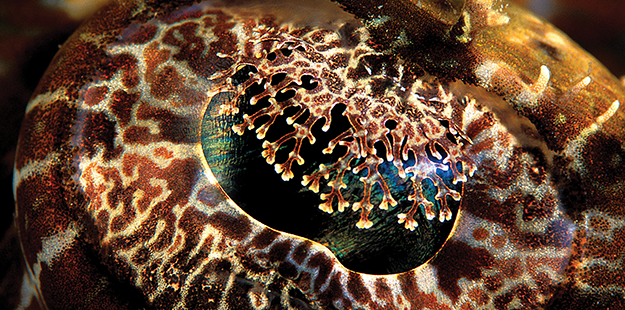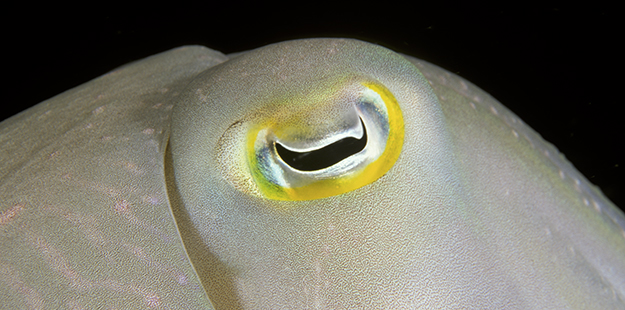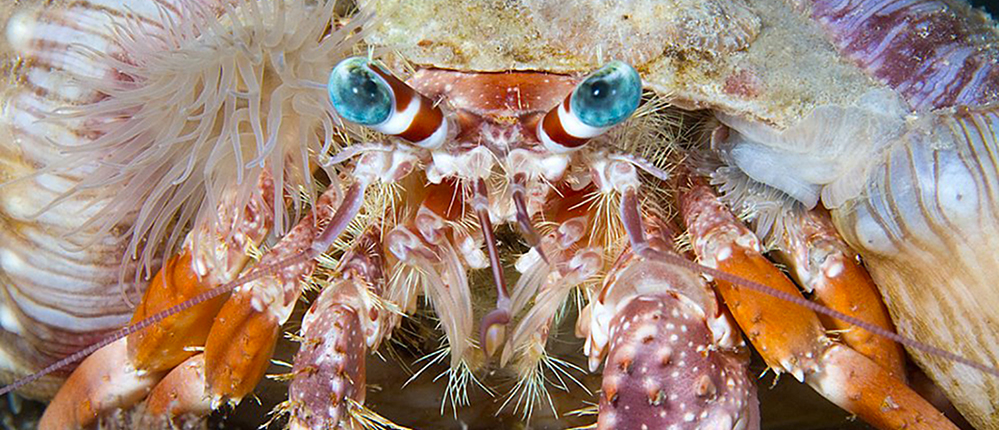Eyes On You
Putting a lid on it
Like their namesake reptile, the crocodilefish is an ambush predator that spends most of its time lying motionless, waiting for a meal to swim by. These fish are masters of camouflage, and can adapt their body’s coloration and patterning to match their surroundings. They have developed an additional trick that helps with concealment: their eyes are fringed in long, lash-like growths known as lappets. The irregular, lacy shapes of these lappet growths help to break up the dark, reflective contours of the eyes, which might otherwise alert potential prey to the crocodilefish’s presence. Divers may have to look close to discover the camouflaged body of the crocodilefish, but once they do, these eyes are a beautiful sight to see.

The lacy lash-like growths, or lappets, on crocodilefish eyes help to break up the dark, reflective contours of the eyes, which might otherwise attract prey. Photo by Wayne MacWilliams
A compound solution
The eyestalks of a hermit crab may give these crustaceans a seemingly comical appearance, but they also provide practical and tactical advantages. The protruding stalks allow the eyes to move in all directions without the crab having to move it’s body. This not only provides a much wider field of vision, but also the capability for binocular vision, which helps the crab to gauge distances. In addition, each eye is actually a collection of compound elements, similar to those of an insect.

The hermit crab’s eyes sit on moveable stalks and up close look like two cannons aiming directly at you. Photo by Rob Darmanin
The multiple elements of each eye contain a range of faceted lenses capture light in the UV range, which allows the hermit crab to detect very small movements in low light. Crab eyes don’t provide fine resolution of details, but they do pick up on bioluminescent colors of the plankton and other crustaceans that makes up their diet, as well as patterns in the shells of other crabs that help differentiate potential mates from rivals.
Playing the angles
Cuttlefish eyes are not only able to process polarized light, but to actually determine the angles at which individual light sources are reflected and refracted. This ability may serve as a form of early warning, as it can show not only movement in all light conditions, including the glare of refracted sunlight, but also disturbances in the water column caused by a moving animal.

The eyes of cuttlefish have a modified horizontal slit-pupil with a distinctive W shape in bright light, while in darkness the pupil is circular. Photo by Walt Stearns
The same ability to see patterns of reflection, refraction and polarization allows the cuttlefish to fine-tune its rapid changes in skin coloration and patterns. These changes are essential to this highly intelligent invertebrate for both camouflage and communication, and it may help with navigation and the location of prey.
These are just some of the ways the creatures of the reefs perceive the world around them. And as interesting as it might be to witness thee world through their eyes, when you are submerged on one of Wakatobi’s vibrant reefs with the sunlight filtering down from above, and the colors of the coral merging into the blue background, you are probably glad you have human eyes behind that face mask, and are able to take in all the beauty the scene has to offer.
Ready to see more incredible marine life than you have ever dreamed possible? Contact us at email: office@wakatobi.com, or complete a quick trip inquiry at wakatobi.com.
Visit us on Facebook.


